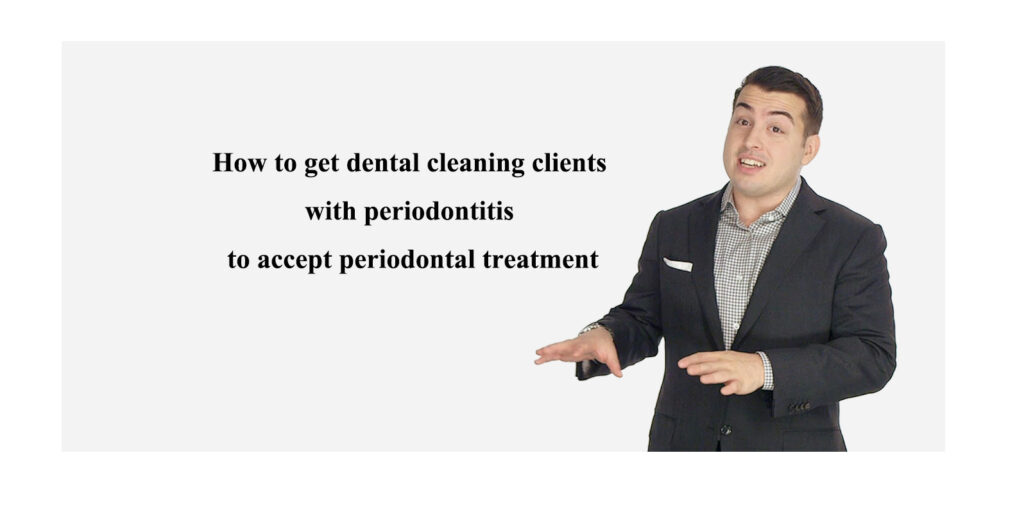
Hello everyone, in this session, the topic is how to get dental cleaning clients with periodontitis to accept periodontal treatment. So, regarding the demographic of dental cleaning clients, there are two groups: young and middle-aged, and middle-aged to elderly. Among these, the majority are middle-aged to elderly clients, and most of them have varying degrees of periodontal disease. This group is quite substantial, but in our actual work, there are still significant communication challenges. Therefore, meeting their needs for dental cleaning isn’t just about addressing periodontal disease or getting them to spend more money. Dental cleaning alone cannot solve the fundamental issues.
On the other hand, let’s consider the motivation of dental cleaning clients. Currently, in clinical practice, there are several reasons why people seek dental cleaning. Firstly, some come for teeth whitening. Secondly, they seek fresh breath because they may have bad breath and either express it or feel embarrassed to discuss it. Thirdly, some come for the treatment of gingivitis. Currently, in clinical practice, the number of people coming specifically for periodontal disease treatment is very low. If someone experiences gum bleeding, they might think they need dental cleaning or have heard from others that they need it. Lastly, there’s a growing population of people who come for regular dental care.
Now, let me share with you the process and techniques for receiving clients. Firstly, instead of immediately examining them, the first step is to ask questions from a marketing perspective. The first point is their dental history – how are their teeth? Also, ask if they’ve had dental cleaning before, when, and where. If they had it locally last year, it implies two things: first, they acknowledge the importance of dental cleaning, and second, if they had it done elsewhere, they might not have been entirely satisfied. So, it’s essential to ask about their experience – was it comfortable? If it was painful, they might avoid dental cleaning in the future. It’s crucial to inquire whether they’ve had dental cleaning before or not. Another scenario is if they haven’t had it before, then ask how they decided to have it today – was it recommended by someone or another reason?
If permitted, ask about their symptoms. Do they experience bleeding while brushing or eating fruits? Do they have sensitivity to hot or cold foods? Do they have bad breath? For older clients, ask if they experience discomfort or looseness in their teeth when eating hard foods.
You can also inquire about their specific expectations, such as if they want their yellow teeth to be whitened or if they want to eliminate gum bleeding.
Furthermore, inquire about their referral source and how they heard about your clinic. If they were recommended by a friend who had a positive experience, it builds trust. However, if they just happened to pass by and decided to visit without prior knowledge, there might be less trust established.
Another aspect is assessing the severity of their concerns. For instance, if they mention severe tooth discoloration, bleeding, or bad breath, ask how much it bothers them.
Moving on to the second step, which is the dental examination. Emphasize that this examination is conducted by a dentist. Some doctors might immediately agree to dental cleaning without a proper examination, which is not professional. Alternatively, conduct the examination while the client is lying in the dental chair. Even if they are just there for a consultation, offer a free examination. After examining their oral condition, communicate with them and let them decide whether they want dental cleaning or not.
Details of the examination are crucial for marketing purposes to satisfy the customer’s psychological needs. Dental cleaning is not just about addressing a disease; it’s a preventive measure driven by psychological needs. Therefore, focus on creating a professional image through these examination details. For example, use sterile examination tools to address patients’ fears of disease transmission or damaging their teeth. Wear gloves and avoid touching other surfaces as much as possible, leaving that to the nurse or using disposable barriers. The examination should be gentle, thorough, and professional. Use communication aids such as intraoral cameras, and invest in high-definition ones.
Afterward, for practicality and ease of storage, it’s convenient to take multiple pictures with the intraoral camera. Firstly, capture images of the oral cavity and its hygiene status, focusing on any bleeding. Additionally, photograph other teeth conditions such as missing teeth and changes in the jawbone, documenting any symptomatic issues. Furthermore, if the patient is willing to pay for a panoramic radiograph, it’s preferable as it provides a comprehensive view. Therefore, with personalized communication tools, including intraoral camera photos and panoramic radiographs, the success rate of persuading customers to accept periodontal treatment can increase by over 50%, even up to 80%.
The third tool is the periodontal probe, preferably with calibrated markings. Use this to demonstrate conditions to the patient, allowing them to see the depth of the problem areas. For instance, with the aid of the intraoral camera, show them areas where probing is normal versus where it indicates deeper issues. This visual aid helps explain the severity of the condition and prepares them for the next steps.
During the examination, it’s essential to collect comprehensive information, especially regarding critical symptoms such as plaque accumulation, oral hygiene, inflammation, and bad breath. After the examination, the third step is the diagnostic briefing. It’s crucial to adopt a customer-oriented approach during this phase as patients have the right to be informed about their condition and treatment options.
The fourth step involves designing treatment plans and allowing the patient to choose. The first option is subgingival scaling and root planing (SRP), also known as periodontal disease treatment. Even if the patient initially declines, it’s essential to present it as an option. The second option is supragingival scaling, commonly known as dental cleaning.
The fifth step involves explaining the treatment options in detail. Discuss the mechanism and effects of periodontal disease treatment and its significance. Engage the patient in the discussion, asking for their preference between the options. Additionally, if they’re hesitant about periodontal treatment, provide recommendations backed by solid reasoning based on their diagnosis.
Finally, the sixth step is to experience the treatment. If the patient is reluctant due to concerns about the complexity or cost, suggest starting with supragingival scaling to control inflammation. Alternatively, suggest treating individual teeth with severe issues first to demonstrate the effectiveness of the treatment. This step aims to build trust and establish a preliminary level of confidence in the treatment and service provided.
In conclusion, by following these steps, dentists can effectively guide patients through the process of understanding their condition, choosing treatment options, and experiencing the treatment, ultimately leading to increased acceptance and success rates in periodontal treatment. Thank you, everyone, for your attention.


